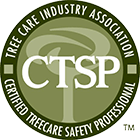Mulch is a wonderful way to care for trees, new and existing. It conserves moisture in soil, promotes a natural rate of evaporation, regulates soil temperature year-round, provides protection from weeds and it looks nice.
Did you know that over-mulching your trees will make them susceptible to damage, and even kill them? When you invest time, and money, to beautify your landscape and provide shade, dead trees likely aren’t your end goal.
Many professional landscapers use a method called volcano mulching. You’ve likely seen it done to trees in cities and towns, as well as private businesses and residences. Volcano mulching is exactly what it sounds like – building up mulch at the base of the tree in the shape of a volcano.
This is not a good way to mulch your trees. Volcano mulching may cause:
- Decay and fungus in the base of the trunk when too much moisture is held in by the mulch
- Soil that is too dry for the roots to spread and create a stable base due to an impenetrable layer of mulch keeping water from filtering down
- Lack of air in the soil, resulting in suffocating the roots
- Insect and rodent damage
The effects of volcano mulching may not show up right away – in fact, unless you’re looking, it can take years for the effects to show. If you were to clear mulch away from the base of a tree that has been over-mulched, you may see that the bark has rotted off and the inside of the tree is exposed. Perhaps the leaves on your trees are smaller than normal, or yellow. Or, in extreme cases, trees with unstable root systems due to volcano mulching could fall over during a storm.
Properly-applied mulch will look somewhat like a flattened donut, with plenty of space in the middle for the flare and root ball to breathe. Here are some tips for how to mulch to promote tree health:
- Immediately after planting a tree, take care to mulch the planting area with 2 to 4 inches of an organic mulch, such as composted wood chips
- If you are applying mulch to an existing tree, carefully create a shallow edge within the drip line of the canopy, taking care to avoid damaging the roots, before you lay mulch down
- Do not mulch up to or against the trunk; start the mulch 6 inches away from the tree trunk. You should be able to see the “flare” at the base of the trunk where the first roots start to branch out
FIND A PROFESSIONAL
A professional arborist can assess your landscape and work with you to determine if your trees are mulched properly or are damaged from improper mulching, and if so, how to correct the issue. CS Tree Services has three board certified TCIA arborists on staff who can give you expert advice. Our full service, fully insured crew can perform any tree services you require.
Call us for your free consultation at 919-355-8299 or visit us at CSTreeServices.com.
Editorial Credit: www.treecaretips.org






